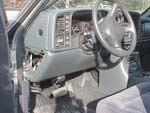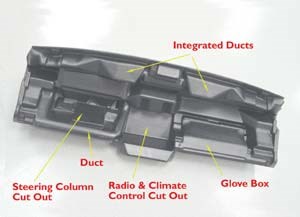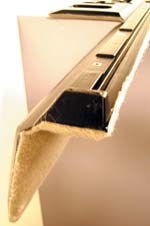Blow Molding Gets Green Light in Detroit
Technical blow molding is changing the contours of automotive interior trim, load-bearing floors, seat-back systems, and under-hood ducting. Favorable economics, process refinements, and the emergence of tailored materials and equipment are taking the brakes off blow molding's earlier limits, and pointing a way to cost cutting.
Building on past successes in fuel systems, the versatility of blow molding for manufacturing complex automotive systems is winning new respect among processors, top-tier systems suppliers, designers, and OEMs. They view technical blow molding as a highway to lightweight and lower-cost interior and under-hood parts at a time when the auto industry is unsettled by a global sales slump. Advances in the blow molding process, along with new materials and equipment designed to meet automotive needs, are opening new avenues for technical blow molding in several application areas.
One promising frontier is interior parts, including safety applications (e.g., knee bolsters); decorative trim (arm rests, consoles, glove boxes); accessories (rear-window shelf and trunk storage); and load-bearing panels (floors and foldable seat backs). In this arena, blow molding promises to deliver stiffer, lighter, and lower-cost components than are feasible with currently dominant injection molding and other approaches.
Another focus for blow molding is heating, ventilating, and air-conditioning (HVAC) reservoirs and ducting. These parts have long been blow molded as a cluster of individual hollow parts located behind the dashboard. The emphasis is shifting to blow molding integrated HVAC systems that save on space and assembly costs and improve noise, vibration, and harshness (NVH) performance.
Under the hood, air-induction and coolant ducting of engineering resins able to meet higher-temperature requirements are attracting new interest. In particular, demand for multi-dimensional, highly convoluted ducting has renewed attention to 3D blow molding machinery. This approach, already well-established in Europe and Japan, is beginning to gain a foothold in North America.
Multi-functional parts
A potent factor behind extrusion blow molding's success is design freedom, says Changize Sadr, v.p. of the Toronto-based ABC Group, an automotive systems provider. In car interiors, multi-functional, one-piece blow molded systems are being exploited to consolidate parts and simplify assembly. An example is ABC Group's prototype instrument panel and integrated ducting system (pictured on the cover and at right), in which eight formerly separate HVAC parts are incorporated into the back side of the IP. This one-part PC/ABS system offers lightweighting and cost-saving potential. Testing is under way and commercial use is anticipated by 2004. Meanwhile, ABC Group is enhancing parts integration and functionality by extending the IP/integrated-duct system to include knee bolsters.
As another example, A-pillars are currently injection molded multi-piece systems consisting of molded skins, ribs, and metal inserts. But ABC Group is prototyping a one-part blow molded A-pillar that would incorporate defroster ducts and use integrated collapsible ribs to improve energy-absorption capacity.
Another example is cited by Michael Moran, engineering manager at Lear Corp.'s Interior Systems Div. in Dearborn, Mich. Lear developed a multi-functional packaging shelf for the DaimlerChrysler PT Cruiser. The shelf is removable and adjustable to five positions for uses ranging from grocery storage to picnicking. It integrates speaker components that improve sound-system quality. It also incorporates integral interior tack-offs that lift its structural strength by 35% while realizing modest weight reduction.
Economics often favor blow molding, says Moran. He cites lower tooling cost than injection molding, plus the relative speed at which blow molds can be built and commissioned in model-changeover and specialty-vehicle programs.
Moran says a critical requirement for interior trim is meeting stringent OEM femur-load limits without adding to part weight. Blow molded knee bolsters achieve that in a one-piece design, whereas injection molded versions require a metal reinforcement. A penalty of two-piece systems is introduction of extra variables (e.g., interfacial relationships, weld strength) so that femur-load results for injection molded two-piece systems typically are more variable and less predictable. Moran says Lear has found blow molded trim meets femur-load limits in more repeatable fashion, which permits downgauging and lightweighting.
New bag of tricks
Blow molding is getting added mileage from several technologies able to enhance stiffness and aesthetics, says consultant Robert Eller of Robert Eller Associates, Akron, Ohio, who authored a recent instrument-panel study. He cites glass reinforcements, high-melt-strength PP resins, living hinges, and in-mold film and textile decoration technologies. Eller notes that work is in progress to allow coextrusion blow molding of multi-layer hard-soft and sandwich structures, a trend that parallels current multi-material injection molding approaches.
Lear, for example, has patented a technology for in-mold bonding of PP-based fabrics directly to PP interior trim, seat backs, and load floors without any adhesive. Moran says melt adhesion of PP backing resin and the PP fiber is relatively easy. The tougher challenge is maintaining parts' dimensional stability because carpet inserts insulate sections of the mold and thereby create unpredictable internal stresses.
A growing trend is use of glass-reinforced materials to blow mold load-bearing floors and space-saving flipper panels used in SUVs. Use of long-glass fibers is also being explored. A 2002-model U.S. vehicle will launch the first blow molded one-piece running board. It is made by ABC Group from 15% glass-reinforced PP. The part replaces a metal waffle plate overmolded with TPE and realizes both weight and cost savings.
Meanwhile, Lear is using 30%-glass PP in a panel to achieve weight and cost savings, in part by replacing far more costly piano-style hinges. Lear has patented technology for putting a living hinge into glass-filled PP. This involves pre-positioning a strip of unreinforced PP homopolymer in the mold prior to introduction of the glass-reinforced PP parison. The strip acts as the hinge and eliminates fracture of glass reinforcement that would impair the panel's integrity. Lear is also exploring an alternative method that coextrudes an unreinforced PP stripe in the glass-reinforced parison to act as the hinge.
Material suppliers are starting to remedy the paucity of suitable resins that has handicapped progress in technical blow molding. This is most evident in PP and TPO, which are favored for interior parts due to their low density and cost. Most standard PPs and TPOs are severely limited by low melt strength, poor sag resistance, and inconsistent die swell.
One of the first materials introduced to counteract these limitations was Basell Polyolefins' high-melt-strength PP. More recently, Dow Automotive developed special TPOs for blow-molding safety trim (knee bolsters) and load-bearing panels. Dow's Inspire TPO's "provide a remarkable balance of stiffness and toughness combined with excellent blow moldability," according to Ravi Ramanathan, a Dow development leader. He says the resins show improved melt extensibility, low sag, and controlled swell properties, which translate into uniform parison stretch. In a prototype rear seat back, one new Dow TPO is said to exhibit excellent flatness and low buzz-squeak-rattle (BSR). Dow Automotive plans to develop a broad slate of blow molding materials, including TPO, PP, nylon, and advanced styrenics, as well as reinforced compounds.
Meanwhile, suppliers of accumulator-head molding equipment, including Uniloy Milacron, SIG Blowtec, Davis-Standard, and Graham Machinery Group (GMG), are working to raise productivity of their machinery. For example, Joe Altimari, business director for industrial equipment at GMG, says dual heads can double output while adding only about 20% to machine cost, thereby lifting productivity per cavity by 40%. What's more, advanced dual-head tooling design allows molders to increase the layflat dimensions of parts like flat panels while using machines of lower capacity (and hence cost) than was feasible a few years ago. In addition, to cope with abrasive effects of glass-reinforced materials, suppliers have adopted hardened steels and coating techniques to protect screws, barrels, and head tooling against wear.
A novel technique to enhance interior part aesthetics is vacuum venting of blow molds. The vacuum removes air trapped in the closed mold, which results in material being molded more forcefully against the tool's wall. Results are enhanced heat transfer for faster cycles, better surface smoothness, and improved precision in complex parts.
Ducting goes 3D
In Europe and Japan, 3D blow molding is an established approach for demanding duct and fuel-system parts. The process allows laying multi-material parisons (sequentially extruded or multi-layer coextruded) into special molds using robotic manipulation and suction. These 3D techniques produce contoured parts that are virtually flash-free, with a minimum of pinch-off points or knit lines that form potential weak spots.
Until now, U.S. blow molders and their equipment suppliers have been skeptical of the viability of 3D blow molding in automotive markets. They have said the process is over-engineered and too costly. But Wolfgang Meyer, president of SIG Plastics Technologies' Industrial Div., points to widespread use of the 3D approach in Europe, where some 60 SIG 3D machines are operating. SIG officials argue that what has been missing is awareness among U.S. designers of 3D capabilities, although that is beginning to change.
Miniature Precision Components in Walworth, Wis., recently installed two SIG 3D machines. MPC is best known as a specialist in injection molded and extruded ducting and fluid-handling parts. "Our decision was sparked by customer demands for more complex, multi-material parts and clinched by our discovery that 3D blow molding meets that need," says Kyla Remus, MPC's market manager. She expects 3D blow molded ducting to be utilized on U.S. vehicles in 2002-03, drawing on nylons, polyesters, and other engineering materials.
3D automotive blow molding is also surfacing in China. SIG Blowtec supplied horizontal 3D molding machines to Yangzhou Auto Plastic Parts in Yangzhou to make air-intake ducting and to Shenyang Jinbei Automotive Co. in Shenyang for ventilation/air-conditioning assemblies. SIG's BlowTec S3 units use six-axis robots for parison manipulation and also have radial wall-thickness-control software.
Molder Steere Enterprises in Tallmadge, Ohio, portrays its patented Dual Process Overmolding (DPO) process as an alternative to 3D blow molding in air-induction ducting. Conventional extrusion blow equipment is used to mold monolayer duct segments using PP, TPV, glass-filled nylon 6, rubber, or other materials. This avoids investment in special equipment while molding parts that include angles, bellows, and snap-fits. Subsequently, four or more segments are joined together with snap-fits, and the assembly is placed in an injection mold, where the joints are overmolded to create flashless, leak-proof, serpentine ducting. Steere also injection molds TPV end-cuffs onto the blow molded ducts to connect the duct to the air filter and throttle body.
"Multi-material ducting made with DPO is our fastest-growing sector," declares David Curtiss, Steere's technical director. He says DPO can create a sharper boundary between dissimilar materials than can be achieved with sequential extrusion. Material interpenetration or "drift" in sequential extrusion can be problematic since it causes variations in the duct's ability to flex in critical areas such as bellows. Curtiss also claims cycle-time reductions for DPO versus sequential 3D blow molding.
Several engineering-resin suppliers are developing materials for 3D ducting. For instance, Ticona has unveiled the first blow moldable version of its glass-reinforced PPS. Fortron SFX375 with 15% glass expands the temperature and chemical resistance envelope as compared with reinforced nylons, says Jim Dutchik, Ticona market manager for powertrain and chassis applications. That opens up potential in air-induction and coolant systems.
Air ducting for turbo-charged vehicles is a high-growth sector of the automotive market. Compressed-air turbo-chargers currently operate at 150 C, a "comfortable" level for 15% glass-reinforced nylon ducting. But a shift to 190 C operating temperatures is expected by 2004 to meet emissions regulations. Dutchik says this trend opens the door for adoption of PPS and that 2004 model-year programs are already in place.
Meanwhile, in coolant ducting, a shift to so-called "long-life coolants" (LLCs) is having an adverse impact on currently used aluminum and nylon systems. LLCs contain aggressive chemicals that cause pitting and other defects in ducting made of metal or plastics having insufficient chemical resistance. But PPS ducts demonstrate excellent resistance to LLCs, Ticona reports.
DuPont Engineering Polymers has installed 3D blow molding equipment at its technical center in Geneva, Switzerland, where it is modifying some engineering materials for advanced blow molding. DuPont has developed 15% glass-reinforced nylon 6 and 66, PBT, and Hytrel copolyester TPE grades specifically for blow molding. A sequentially extruded air duct for Audi used a rigid PBT body and flexible Hytrel bellows section to replace parts that previously required costly assembly. For high-temperature applications under the hood, DuPont is also working on a blow moldable version of its Zenite LCP.
Meanwhile, EMS-Grivory North America is introducing to the U.S. grades of Grilon nylon 6 and nylon 6 elastomer and Grilamid nylon 12 initially developed in Europe for blow molded ducting. Ramesh Iyer, manager of EMS-Grivory's automotive group, says the target is air induction and coolant ducting in turbo-charged trucks, a sector dependent on multi-component metal-and-rubber systems to meet high-temperature and glycol-resistance requirements.
Iyer predicts a shift in air-induction ducting to sequential and multi-layer coextruded hard-soft structures (e.g., nylon 6 and EXL nylon elastomer) that offer parts consolidation and elimination of mechanical clamps. In coolant ducts, where glycol resistance is needed, EMS-Grivory has developed materials for a three-layer coextrusion of a glycol-resistant polyolefin, tie layer, and nylon 12.
Related Content
First Water Bottles With Ultrathin Glass Coating
Long used for sensitive juices and carbonated soft drinks, KHS Freshsafe PET Plasmax vapor-deposited glass coating is now providing freshness and flavor protection for PET mineral water bottles.
Read MoreFor Extrusion and Injection-Blow Molders, Numerous Upgrades in Machines and Services
Uniloy is revising its machinery lines across the board and strengthening after-sales services in tooling maintenance, spare parts and tech service.
Read MoreBreaking News From NPE2024
Here is a firsthand report of news in injection molding, extrusion, blow molding and recycling not previously covered.
Read MoreRead Next
Making the Circular Economy a Reality
Driven by brand owner demands and new worldwide legislation, the entire supply chain is working toward the shift to circularity, with some evidence the circular economy has already begun.
Read MoreLead the Conversation, Change the Conversation
Coverage of single-use plastics can be both misleading and demoralizing. Here are 10 tips for changing the perception of the plastics industry at your company and in your community.
Read MorePeople 4.0 – How to Get Buy-In from Your Staff for Industry 4.0 Systems
Implementing a production monitoring system as the foundation of a ‘smart factory’ is about integrating people with new technology as much as it is about integrating machines and computers. Here are tips from a company that has gone through the process.
Read More


























